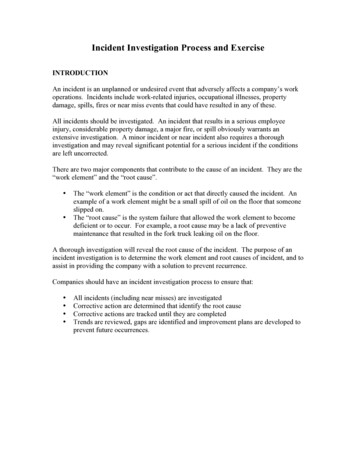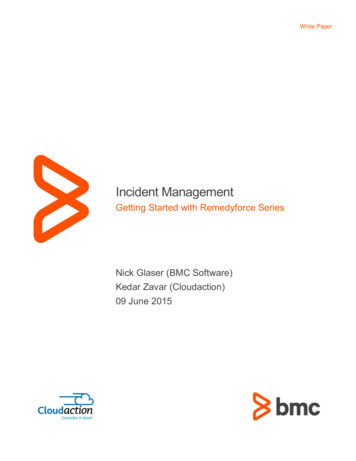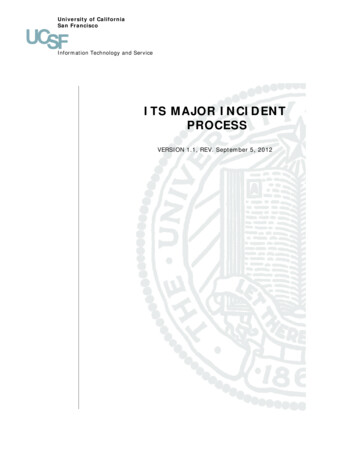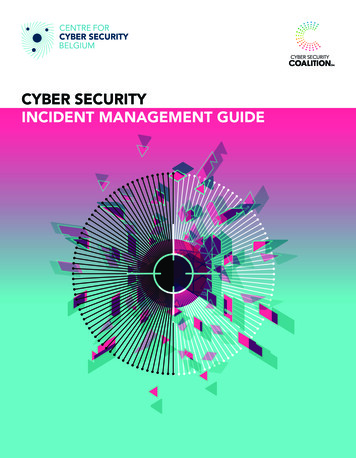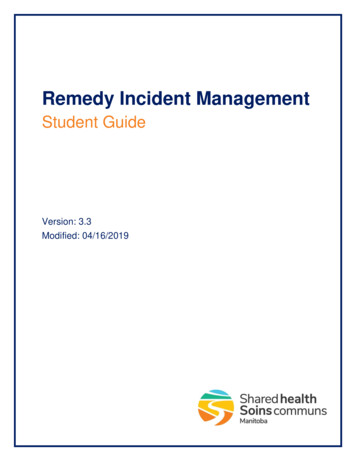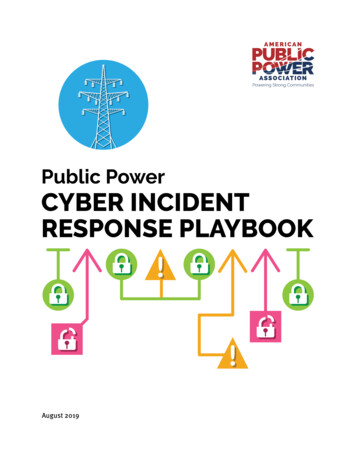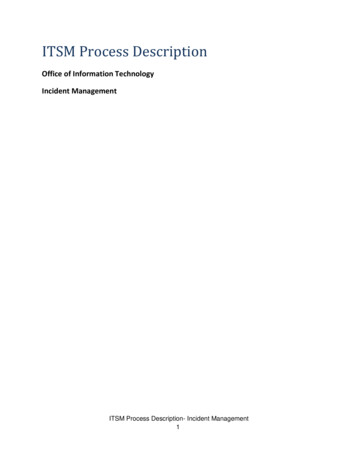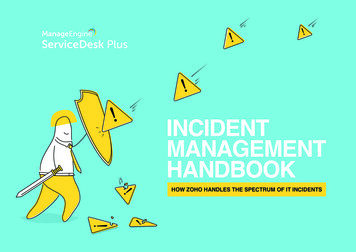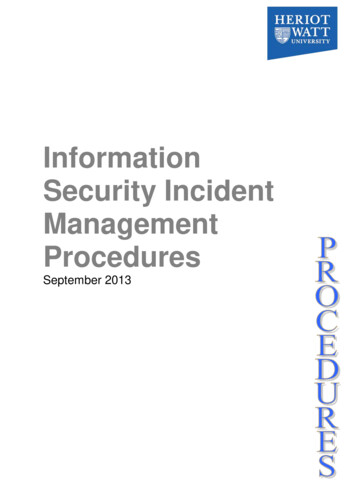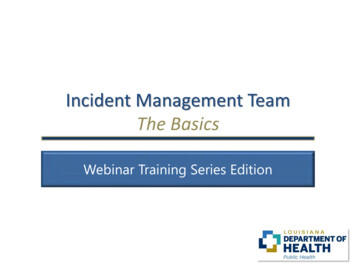
Transcription
Incident Management TeamThe BasicsWebinar Training Series Edition
PurposeThis training provides an overview of the roles andresponsibilities of an Incident Management Team (IMT). Itincludes suggested systems, tools, and best practices useful inmanaging an incident response.
Objectives Describe the Incident Management Team as a concept andhow it can be applied during a response Provide a section-by-section illustration of duties and areas ofconcern for an IMT Describe specific systems that must be in place for an IMT tofulfill its responsibilities Discuss best practices for incident management specific toLDH emergency response activities
Incident Management Team An IMT refers to the command and control portion of anIncident Command System organization. Also referred to as the Command and General Staff Composed of the Incident Commander (and Deputy), SafetyOfficer, Public Information Officer, and the Section Chiefs (andtheir deputies). Responsible for organizing and directing response activities toachieve the incident objectives and to address the threeuniversal incident priorities of life safety, incident stabilization,and preservation of property.
Characteristics of an IMT Generally manages a specific type of incident Compose of individuals possessing expertise and skillsrelevant to the specific response Train together and work together on the same incidents Able to apply their incident management skills at differentlevels of response
Incident Management Team Training: The BasicsSECTION RESPONSIBILITIES ANDINCIDENT MANAGEMENT SYSTEMS
Incident Management Team Training: The BasicsLOGISTICS
Logistics ResponsibilitiesResponsible providing material support to incident responseactivities Equipment Supplies Communications Facilities Transport
Logistics Required SystemsResource Acquisition Sources for anticipated equipment and supply needs (primaryand backup) Resource agreements Defined resource ordering process Accurate order tracking process (order to receipt) Process (and site) for receipt and storage of equipment andsupplies Comprehensive inventory system
Logistics Required SystemsCommunications Redundant communication platforms Interoperability with partner organizations Defined communication plan for use of each platform– Who uses it– For what purpose– Operational details (radio channels, email addresses, etc.) Defined fallback plan if primary systems should be unavailable Testing procedures for all platforms (with an establishedschedule)
Logistics Required SystemsFacilities Complete list of potential sites to use as incident facilities(including relevant features) Defined footprint for a site based on the specific responseoperation Equipment and supply lists specific to each type of operation Defined set-up plan for placement of equipment (withassigned responsibilities) Process for addressing site maintenance issues Procedure for providing meals to assigned staff (if applicable)
Logistics Required SystemsTransport Complete list of available transport assets and method ofacquisition Validated list of authorized drivers Process for assigning vehicles (check-in/check-out) Process for vehicle fueling and maintenance Agency policies regarding use of transportation assets
Incident Management Team Training: The BasicsPLANNING
Planning ResponsibilitiesResponsible for information collection, analysis, anddissemination Organization of response processes Incident Documentation Situational reporting Maintaining status of resources Long-term planning
Planning Required SystemsOrganization of Response Processes Procedures for managing the planning process Procedures for providing relevant briefings to response staff Procedures for dissemination of information to outsidepartners and agencies Detailed information on response personnel assignments
Planning Required SystemsIncident Documentation Procedures for creation of Incident Action Plans (IAP) Process for summarizing incident data (any type) in usableformat for specific audiences Accurate contact information for key personnel and outsidepartners Complete address and contact information for any incidentresponse facilities being used
Planning Required SystemsSituational Reporting Methods for determining what information should becollected Procedures for collecting incident data about responseoperations Process for doing data analysis, data validation, and creatingdata summaries
Planning Required SystemsMaintaining Status of Resources Comprehensive resource (support) request tracking– Nothing is lost or overlooked– What is requested is what is received Process to validate requests– Frivolous requests– Duplicate requests Procedure for confirming receipt by requestor
Planning Required SystemsLong-Term Planning Methods for projecting resource needs over different periodsof time Processes for anticipating future issues Demobilization planning and demob processes Back-up processes for every other process– Planning Section– All other Sections
Incident Management Team Training: The BasicsADMIN-FINANCE
Admin-Finance ResponsibilitiesResponsible for financial accountability, timekeeping, humanresource issues, and general administrative oversight Expenditure tracking Contract monitoring Staffing issues Payroll issues
Admin-Finance Required SystemsExpenditure Tracking Process for collecting cost information (prior to expenditurewhenever possible) Standard format for reporting expenditures Procedures for creating cost projections for near and longterm response
Admin-Finance Required SystemsContract Monitoring Complete list of contracts active in the incident response Process for monitoring contract execution Process for reporting contract activities to primary contractowner/monitor
Admin-Finance Required SystemsStaffing Issues Process for determining what staff are assigned to theincident response– Accurate list of personnel assigned to incident response rolls– Interface with Planning for resource (personnel) monitoring Process for acquiring additional staff as needed Process for handling no-shows and non-compliant staff
Admin-Finance Required SystemsPayroll Issues Procedures for tracking staff time Procedures for validation (auditing) of time sheets Procedures for correcting timesheet errors– Off-shift staff– Demobilized staff Process for training staff on use of time-tracking procedures
Incident Management Team Training: The BasicsOPERATIONS
Operations ResponsibilitiesResponsible for direction and oversight of tactical resources Creation of response strategies Assignment of tactical resources Monitoring of response progress
Operations Required SystemsCreation of Response Strategies Methods for defining the scope of the incident Process for determining what tactical resources are available Process for identifying additional needed resources
Operations Required SystemsAssignment of Tactical Resources Process for assessing priority needs Process for assessing capabilities of tactical resources Procedure for communicating resource assignments toOperations supervisors
Operations Required SystemsMonitoring of Response Progress Defined criteria for successful operations Methods for comparing real-world outcomes to desiredoutcomes (evaluation) Process for identifying issues and making improvements toresponse operations Process for determining need for additional resources Process for determining presence of excess resources
Incident Management Team Training: The BasicsCOMMAND
Command ResponsibilitiesResponsible for overall direction of incident response activities Creation of incident objectives Reallocation of incident response assets Resolution of policy-related issues Determination of demobilization priorities Communication with larger incident management structure
Command ConsiderationsCreation of Incident Objectives Ensure that objectives align with overall agency mission Ensure that objectives provide clear direction Avoid tactical-level planning Adjust objectives as the incident evolves
Command ConsiderationsReallocation of Assets Routinely assess current workload of each section Determine if resources are being used efficiently Reassign staff and other resources to best address the overallmission Don’t be limited by original resource assignments
Command ConsiderationsResolution of Policy Issues Determine if the policy is being applied appropriately Determine if the policy is significantly hindering the response Consult with higher incident management structure forpossible solutions
Command ConsiderationsDetermination of Demobilization Priorities Routinely monitor resource usage, particularly staff workload Assess incident priorities to determine if specific resourcesare still needed Direct relevant Sections to conduct position-level staff needassessments based on projected activities Approve or adjust demobilization plan as appropriate
Command ConsiderationsCommunication with Larger Incident Management Structure Be prepared to answer any question about your responseactivities or capabilities at any time Offer candid assessments of leadership directives Anticipate leadership questions and prepare informationsummaries backed by specific data Maintain routine contact with next link in chain of command Always seek clarification for unclear directives Bring potential issues to the attention of superiors before theybecome a problem
Incident Management Team Training: The BasicsBEST PRACTICES
Incident Management Best Practices Always follow the established chain-of-command Know your agency’s response priorities and mission (Stay inYour Lane) Understand who the players are in each incident response Specific information is always better than vague information Be prepared to answer the question that no one has everasked (yet)
Incident Management Best Practices Validate all resource needs before requesting resources– Distinguish between “must have” and “nice to have”– Determine realistic timetables for resource needs Enforce accountability for responsibility– Make clear assignments for each position– Supervisors should offer useful feedback and spot-train as necessary Be mindful of one another– This work is stressful– No one can work for days without sleep (no matter what they mayclaim)– Routinely take time to ask how someone is doing
Incident Management Team Training: The BasicsTHE END
The Basics Webinar Training Series Edition. Purpose This training provides an overview of the roles and responsibilities of an Incident Management Team (IMT). It includes suggested systems, tools, and best prac
